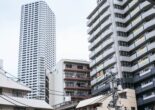This article covers the differences between 1R, 1K, 1DK, and 1LDK apartments, as well as some tips for reading Japanese floor plans.

Apartment-hunting in Japan can be difficult. Not only is there a language barrier, but the apartments are designated differently than they might be in your home country. In Japan, room types are categorized into four major types: R, K, DK, and LDK. Let’s take a look at what each apartment style means, and what the benefits are for each.
Understanding Japanese Floor Plans
Before we get into the different types of apartments, it might be helpful to understand the basic Japanese floor plan.

Floor space is measured in one of two ways: square meters (m2) and 帖 (jou). 帖 is the measurement of one standard tatami mat: 1.62 m2. Sometimes, 帖 will be represented by the letter “J.”
Here is a list of symbols you will always see on the floor plan and what they mean:
- 玄: abbreviation of “玄関” (genkan), or the entry space where you put your shoes
- 洗: lit. “wash,” this small box indicates where you will put your washing machine; sometimes it is outside, on the balcony. Remember there can be noise etiquette to adhere to when your washing machine is outside!
- WC: This means “Water Closet”…the toilet area
- 浴室 (yokushitsu): This is the actual show/bath room.
- CL: Closet
- 和室 (washitsu): this represents a Japanese-style tatami room
- 洋室 (youshitsu): this is a western-style room (no tatami flooring)
- ベランダ/バルコニー (beranda/barukoni): One of these words will be used to designate any veranda or balcony space the apartment might have.
With these things in mind, here are the categories of room types for Japanese apartments.
1R: The Studio Apartments of Japan

1R apartments are also called ワンルーム (wanru—mu) in Japanese. They are essentially studio apartments and measure between 13~20 m2. The kitchen of a 1R apartment will usually be on your left as you enter, and the bathroom will be opposite the kitchen on your right. The kitchen space of a 1R apartment is generally small, with a one-burner stove and very little cupboard space. To save room, the bathroom will typically be a unit-style, meaning that the toilet and bath/shower area are in the same room. Modern 1R apartments in urban areas might have a loft area for sleeping. Be aware that these can be hot in the summertime and that taller residents might not be able to sit or stand up straight.

The benefit of a 1R apartment is its affordability. Even in Tokyo, a student might be able to rent a 1R apartment. Things to keep in mind include food smells from the kitchen saturating linens and clothes, as well as the fact that your apartment might not have enough space for both a full-sized fridge and a washing machine. There is also rarely enough room for closet space, so you’ll have to buy your own storage.
1K & 2K: More Space for Cooking
1K apartments are a great option if you want the affordability of a 1R but prefer to keep the food smell out of your clothes. Although they are only a bit larger than 1R apartments (the largest 1K room averages at 25m2), 1K apartments have a wall separating the kitchen space and the bedroom area. That said, there is not much else that makes a 1K apartment stand apart from the 1R: the bath is still typically a unit, storage space isn’t promised, and the stove will still only have one burner.
There are 2K apartments on the market, however. This means the apartment has a kitchen space and two separate rooms. Bear in mind that these rooms might not be very spacious.
DK: Dining-Kitchen Apartments

Unlike 1R and 1K apartments, DK apartments have more generous space for cooking and eating. DK stands for “dining-kitchen,” and indicates that the kitchen space has been expanded for eating purposes. This means a larger apartment overall: DK apartments range between 25~30m2. A 1DK apartment has this larger kitchen-dining space connected to the entrance, with one separate bedroom. A 2DK will have the kitchen-dining space plus two rooms, and so on.
The benefits of DK apartments are the size and likelihood of extra storage space provided. The toilet and bath-shower rooms are more likely to be separate as well. You are guaranteed to have space for a full fridge, and it is most likely that the stove will have more than one burner. The downside is that the price goes up; DK apartments are less affordable for students or short-time visitors.
LDK: Living-Dining Kitchen Apartments

The final and largest of the four categories, LDK apartments are usually between 25~35m2. LDK stands for living-dining-kitchen, which usually means there is a kitchen space with a full counter (or the space for a counter) that separates it from the living-dining area. An LDK apartment will have this space and one separate room. The bathroom is almost certainly separate from the shower-bath area, unless the building is old. In an LDK apartment you are guaranteed to have at least one closet space. There is a higher probability that the washer can be kept inside. It isn’t uncommon for LDK apartments to range in room number; 2LDK and 3LDK apartments are common and cater towards families. Sometimes an LDK apartment will even have a walk-in closet or loft. In this case, it will be designated an SLDK, with the “S” standing for “service room.” The service room, though smaller than a regular room, can often be turned into a child’s room or playroom.
LDK apartments are certainly the most expensive if they’re new. However, if you don’t feel like sacrificing living space for the cost, LDK apartments are the most likely to give you the comfort of breathing room. They are ideal for couples, families, or someone looking to live with a roommate.
Author: Erin Himeno



